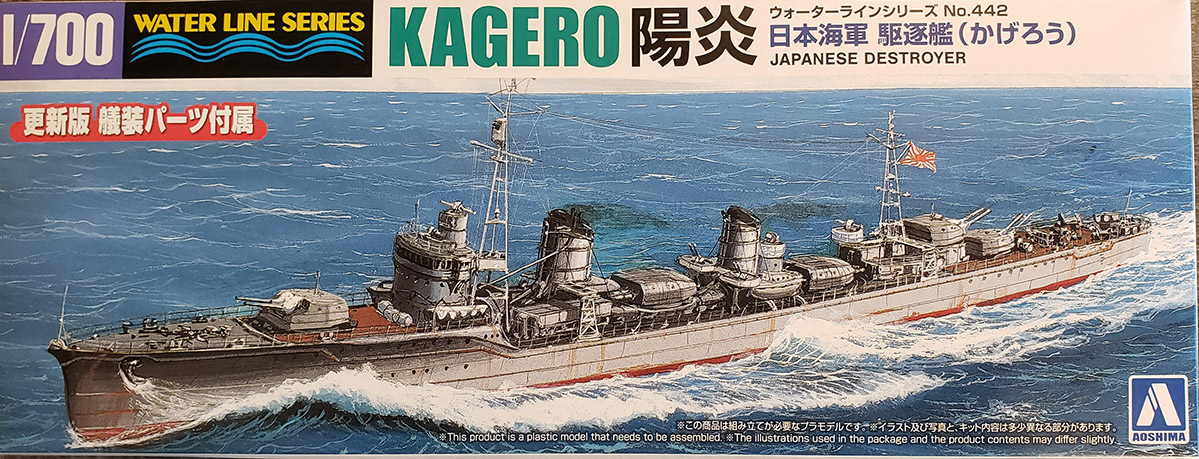

|
by Dan Kaplan |
| Background | |||||||||||||||
|
The
background, design and history of this ship and class have been covered
in my review of the Flyhawk/Pit-road 1/700 Kagero kit in 2020. A timeline
and comments regarding the other 1/700 Kagero class kits that are currently
available are also discussed in the same review.
See here: http://www.modelwarships.com/reviews/ships/ijn/dd/kagero/700-pr-dk/index.htm |
|||||||||||||||
| The
Review Kit:
This tooling was introduced by Aoshima in 2003 and used for kits of several sisters (nine by my count) in the class. While subsequent 1/700 Kagero class kits from other manufacturers have since surpassed Aoshima in terms of detail, this kit remains a good, reasonably accurate representation of the class. Though this review will examine all the components of this kit, its main purpose is to review the new accessory sprues that Aoshima has included as their way to update the kit. Aoshima is hardly the only company to upgrade their kits in this way; Fujimi has long utilized this approach, and Pit-road is a relatively recent adapter of new sprues to freshen up its kits. The kit is molded in a medium grey styrene and
comes with 10 different sprues. While there are greater than 100 pieces
included, only about 70 are utilized for the kit. Most of the unutilized
parts are weapons and equipment that have been superseded by newer versions.
Some spares among the newer pieces are a byproduct of the build.
|
|||||||||||||||
| HULL (ORIGINAL) | |||||||||||||||
| The hull is a one-piece waterline
hull, very cleanly molded. It lies mostly flat. There is very little detail
shown on the hull sides – no portholes, hull strakes, or a degaussing cable,
and barely carved out anchor recesses, but the hull is well shaped, particularly
the bow form.
The main deck and forecastle are integrated into the hull, as are the aft deck house and center superstructure, including the main air intake, the raised platform for number one torpedo mount, and the bases of the funnel. The decks show the base rings for the main mounts, molded on hawser reels, a paravane winch, and assorted hatches. Very finely molded linoleum tie-down lines are present, as are the rails for the torpedo trolley. The bulkheads could stand better detailing with aftermarket accessories (particularly the aft deckhouse), and the tiedowns will disappear under heavy paint, but what’s there is nicely molded and properly scaled. The stern portion of the decking is covered with very finely treaded metal plating. The athwartship depth charge rack at the stern is a solid block of plastic and needs to be replaced with either a molded rack or a photoetch one. Unfortunate but common for most Kagero class kits, circular air vents are molded on top of the aft deck house instead of rectangular torpedo adjustment tables. The hull is slightly under scale for a Kagero type.
Unlike other kits, the bull nose is integrated into the hull portion, allowing
for more precise measurements. The class particulars versus the scale and
this kit are:
|
|||||||||||||||
|
|||||||||||||||
| BOTTOM SPRUE (ORIGINAL) | |||||||||||||||
| It’s comprised of the waterline plate and the treaded portion of the forecastle deck. The forecastle deck is molded with anchor chains, capstan, and hawseholes. Everything is rendered very sharply, and to scale, so much so those components seem almost undersized compared to other kits. The plate is not a hidden plate, but one that adds about 1mm to freeboard. No metal bar to weigh the hull down is included, as was typical of the series in earlier times. | |||||||||||||||
|
|||||||||||||||
| A-048 SPRUE (ORIGINAL) | |||||||||||||||
| This is the main parts sprue from
the original kit. It includes all the components of the bridge except the
compass bridge deck, the funnels and their auxiliary pipes, air intakes
at the funnel bases, galley pipe, main gun and torpedo directors, forward
torpedo reload stowage boxes, all the components for the torpedo reload
gantries, the main mast, and the three main turrets along with a turret
base ring. These turrets and base ring are not to be used.
Detailing is basic, but everything is very sharply molded. The auxiliary piping and aft mast legs are all uniformly thin in diameter. I especially like that the AA bandstand for two twin 25mm guns mounted in front of funnel number two is without solid siding. This allows for proper PE railings to be attached without extra work. |
|||||||||||||||
|
|||||||||||||||
| B-048 SPRUE (ORIGINAL) | |||||||||||||||
| A smaller sprue that contains the fore and aft legs of the foremast, the compass bridge deck, and a base ring for one of the main turrets. The legs are all properly thin for this scale, yet stiff enough to provide a decent amount of support. | |||||||||||||||
|
|||||||||||||||
| SE SPRUE (NEW) | |||||||||||||||
| Contains the three main Type
“C” turrets, plus barrels with blast bags. These are certainly a major
improvement over the original turrets that are still included with the
kit. They are more sharply molded and truer to shape, with better detailing
that includes the air vents that were placed on the side of the turret,
very fine molded handrails atop the turret, and structural stiffeners that
wrap around the turret. Additionally, the barrel/blast bag is molded as
a single unit and not as part of a twin set-up. So, it makes for a more
accurate depiction of the barrel mounted in its individual sleeve.
The two knocks against this new turret are that there is only one hatch for access at the rear of the turret instead of two, and the stiffening bands were only applicable to number one turret until the advent of the Yugumo class. The hatch can be scraped off and replaced with styrene, while bands around all the turrets are common among new turrets produced for IJN 1/700 DDs from most manufacturers. With patience, they can be removed with a sharp blade. |
|||||||||||||||
|
|||||||||||||||
| SG SPRUE (NEW) | |||||||||||||||
| Four Type 92 Mod. 4 torpedo tubes and shields are held on this one. Like the turrets, everything is superbly detailed and to scale. Also like the turrets, these mounts are a vast improvement over the Waterline Consortium equipment set versions that previously came packaged with these kits. These are also superior to the new Hasegawa versions that come with their new Yugumo class kits as well as being very close in appearance to other modern versions from Pit-road and FineMolds. Note that the more accurate scale size will mean a tighter fit in the space allowed for the tubes on deck. The kit only uses two sets of tubes and mounts, so there are two spares. | |||||||||||||||
|
|||||||||||||||
| SI SPRUE (NEW) | |||||||||||||||
| This sprue holds chrysanthemum shields
(two sizes), anchors (3 sizes), depth charge Y-throwers, Type 22 and Type
13 radars, RDF antennas, davit mounted paravanes for destroyers, and Type
94 HA directors. Everything is very sharply molded and properly scaled.
1/700 injection molded Type 13 radars are never going to approach the proper detail that a photoetch version can offer, but these are well done for what they are. The same can be said of the RDF loop antennas. The Type 94 directors are also excellent, but they aren’t used for this kit. So, good for the spares box, along with many other items on this sprue. |
|||||||||||||||
|
|||||||||||||||
| SJ SPRUE (NEW) | |||||||||||||||
| This sprue of clear plastic pertains solely to searchlights. There are four types on the sprue: 30cm, 60cm, 90cm, and 110cm versions. The 30cm were used for signaling, the 60cm was common to older destroyers (Mutsuki and earlier classes), the 90cm was used on the more modern destroyers, and the 110cm was standard for larger vessels excepting the Yamatos. All are crisply molded and approach the quality of those produced by Fine Molds, but not quite as good. Still, they are an enormous improvement for Aoshima. | |||||||||||||||
|
|||||||||||||||
| SK SPRUE (NEW) | |||||||||||||||
| Dedicated to small weapons, the balance
of these mounts are twin and triple 25mm AA guns, all unshielded. There’s
also two 40mm single mounts (used on the Hatsuharu and Shiratsuyu classes
in their pre-war fits) and two single barrel 14cm/40cal mounts meant for
submarines. At least, that’s what I think they are, given that Aoshima
has multiple 1/700 IJN submarine kits, as well as Hatsuharu class kits.
The 25mm mounts are certainly an improvement over the previous consortium sprue mounts, and more properly sized. Still, I think it’s hard to surpass the 25mm mounts from the FineMolds Nanodread line. The 40mm and 14cm guns are very nicely done. Again, there will be plenty of spares. |
|||||||||||||||
|
|||||||||||||||
| SL SPRUE (NEW) | |||||||||||||||
| This last sprue is dedicated to ship’s
boats and their equipment. There are plenty of boats here, including 7m
and 9m cutters, 7m, 9m, and 11m motorboats, and 12 m motor launches, Plus,
davits of all sizes. All the boats are better shaped, detailed and scaled
than what the Waterline Consortium sets offer. The same can be said about
the davits.
The 7m cutters and motorboats are what applies to this kit. |
|||||||||||||||
|
|||||||||||||||
| DECALS (NEW) | |||||||||||||||
| One full color decal sheet replaces
the old paper decal sheet. It is clearly printed with no registration issues.
Topping the sheet are several Japanese flags, including a very welcome
version that can portray the flag as waving while underway. Several rows
of large and small, red Japanese hinomaru (roundels) for the wings and
fuselage of Japanese aircraft follow, as does some striping and defensive
sight lines for aircraft tailplanes.
Nothing other than the flags should be used for this kit. |
|||||||||||||||
|
|||||||||||||||
| INSTRUCTIONS (REVISED) | |||||||||||||||
| This consists of one large sheet printed
front and back in black and white, then folded into four pages. One page
portrays the usual b & w reprint of the cover art, and carries various
product admonitions in several languages, the second page carries plan
and line drawing views with color callouts tied to the GSI Creos line of
paints for painting, and the rest of this page and the third shows a step-by-step
progression of assembly using exploded, three-point perspective illustrations.
The sequence of illustrations has been carried over from the original kits
and modified to include the new parts. The fourth page shows the sprue
layouts and highlights the unused parts.
Interestingly, a separate sheet printed in color also displays carries plan and line drawing views with color callouts tied to the GSI Creos line of paints. It’s a nice touch. |
|||||||||||||||
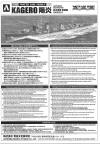 |
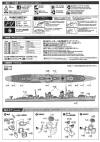 |
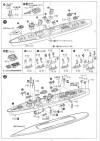 |
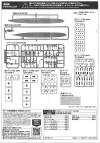 |
||||||||||||
 |
|||||||||||||||
| FINAL THOUGHTS | |||||||||||||||
| I bought
this kit to satisfy my curiosity about Aoshima’s new accessory sprues.
While the kit and its new accessories are not at the same detail level
as the current benchmark 2020/22 Kagero class releases from Flyhawk-Pit-road,
the new parts certainly help to raise the level of the Aoshima kit and
keep it somewhat relevant. I see this latest version as a cost-effective
alternative to the newer kits from other companies. This is particularly
true if the modeler is not obsessed with the level of detailing that these
other kits provide. Keep in mind that Aoshima is re-releasing all its kits
of this class with the new sprues.
Recommended. This kit’s SKU # is AOS-033531 and it came courtesy of my wallet via Hobbylink Japan. This kit is available domestically, from overseas, and via the internet. The US retail cost is approximately $15 to $16, but it is usually discounted. Overseas and eBay prices can be slightly lower but usually don’t include shipping. |
|||||||||||||||
